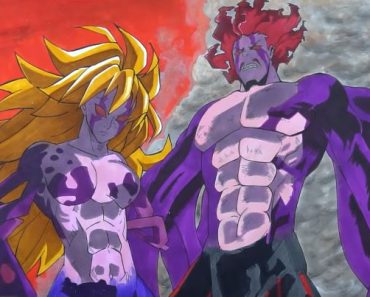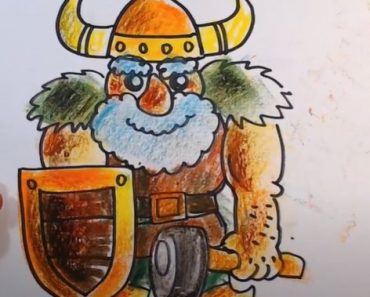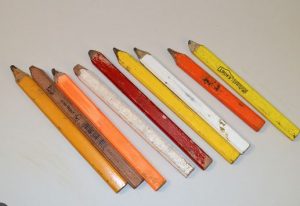
The history of pencils dates back 5 millennia to ancient Egypt.
By the 16th century, lead-filled wooden sticks had replaced the Egyptian stylus. Soon, however, pencils were created using graphite.
Although there is no lead in what is traditionally called a “pencil”, these writing instruments are quite versatile:
– They are erasable!
– They work in any temperature – and upside down or overhead.
– They are extremely cheap to manufacture.
– They are light in weight and easy to handle.
– They come in a variety of colors to match poorly lit workspaces.
– They can be made with sixteen degrees of “hardness”, which is determined by the amount of graphite used in production.
Hard pencils – denoted by the letter “H,” leave less graphite, have a grayer color, and are often used for technical drawing.
Softer pencils, denoted by the letter “B,” are an indication of how dark the pencil is. In other words, the letter B represents the darkness of this line. The softer the pencil, the more graphite it leaves on the writing surface. Soft pencils are mainly used for drawing art.
The traditional yellow pencil that I used to learn in school is the most popular but certainly not the only one. Today, there are watercolor pencils, mechanical pencils, masonry pencils, colored pencils, and even grease pencils, plus many more.
And then there’s the carpenter’s pencil – the infamous flat pencil.
Why are Carpenter’s Pencils Flat?
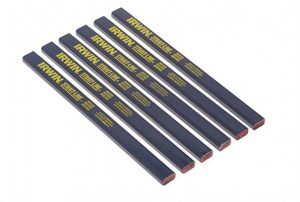
As an added bonus, the carpenter’s pencil’s unusual shape and design allow for an easier grip (and larger grip area) than standard pencils.
The carpenter’s pencil can mark/write on brick, wood, or concrete surfaces, etc. The carpenter’s pencil is strong and manufactured using durable solid graphite. The core of the pencil will be less likely to break and splinter.
The pencil’s non-circular design ensures it stays where placed, so the carpenter reaches for it again – they can be assured it hasn’t rolled away. This is especially helpful (and a whole lot safer) when perched on a ladder high above a marble floor.
Design
The design shape of the carpenter pencil is almost elliptical – with distinctly flat edges. However, if you look directly at a carpenter’s pencil from above – it looks like an ice cream cone.
Carpenter pencil size
Carpenter pencils come in a variety of sizes and shapes. But the size of the most commonly used pencil is:
– 19/32 inches wide.
– 1/4 tall.
– About 7 inches long.
To provide some perspective, the pencils filled with my childhood memories, now manufactured as hexagons, are about 7 ½ inches long, ¼ inch wide, or 8/32 – more than half the width of the carpenter’s pencil.
The sizes of this pencil are dual-purpose – handy marking tool that can be used to measure non-repeating intervals.
Masonry & Multigraph Pencils
All-purpose pencils and masonry pencils are made to meet the needs of construction workers and carpenters but for more specific purposes. For example, construction pencils (Extra Hard Lead in 6H) are great for writing on hard or porous surfaces – like stone and concrete. The lines left by masonry and other hard pencils are gray rather than black.
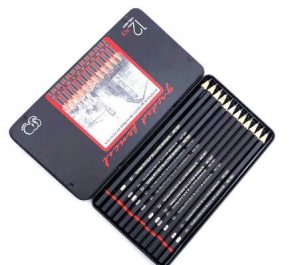
The All-Purpose Pencil (aka Lead Graphite 7B) is designed for writing on smooth surfaces – glass, metal, tile, and more.
“The standard shape of a multi-graph pencil is a triangle” – that’s why it’s also called a triangular pencil. But note, I’ve also seen oval multipurpose pencils.
Sharpening a Carpenter’s Pencil
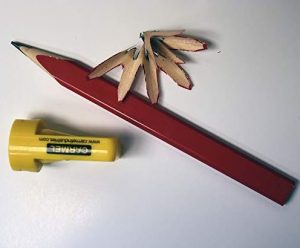
Carpenter’s graphite, shaped like a thin rectangle, creates a much-needed wider writing surface. It also helps to prevent rapid skin dullness. However, this does not mean that a carpenter’s pencil will not break or need sharpening at some point.
There are two ways to sharpen a carpenter’s pencil.
The tried method is to use a standard utility knife. Many would argue that this traditional way – known as the punch method, is still the best. Simply and carefully trim away the outer wood on the pencil until you reach the graphite. Then grind it to meet your needs.
There are also manual sharpeners that fit on the tool belt. Of course, there are also electric pencil sharpeners designed for the oddly shaped carpenter’s pencil, available at most major retail stores and online.
Pro Tip – Keep each tip sharp. This saves time if a pencil tip breaks during work.
Professionals are always ahead of the game by sharpening both ends of the pencil at the same time. Smart contractors even take the time to create different sized tips. The thicker tip will produce thicker lines, while the thinner tip can be used for a more precise finish.
Pro Tip – Keep each tip sharp. This saves time if a pencil tip breaks during work.
Professionals are always ahead of the game by sharpening both ends of the pencil at the same time. Smart contractors even take the time to create different sized tips. The thicker tip will produce thicker lines, while the thinner tip can be used for a more precise finish.
Each of these tip sizes can be used on a variety of surfaces and materials.
The Take-Away

While carpenter’s pencils may seem like the oddball out of the world of writing tools, the reality is that they’re smart, affordable, and on the list of carpentry’s unsung heroes.
They can help mark up a project while creating repetitive spaces with remarkable precision.
From a simple beginning, the pencil has become a star in the worlds of construction, engineering, architecture and art – with its ability to measure spaces over and over with precision.
